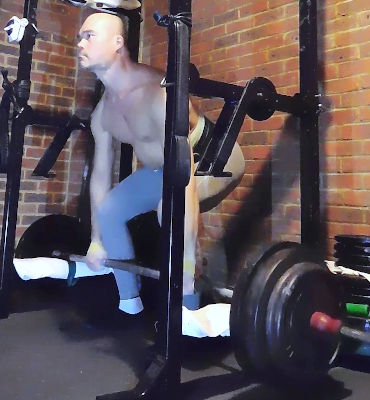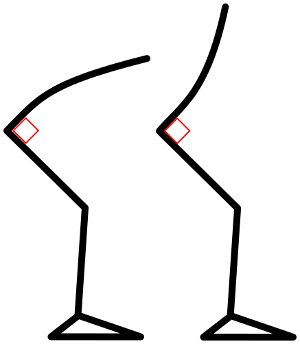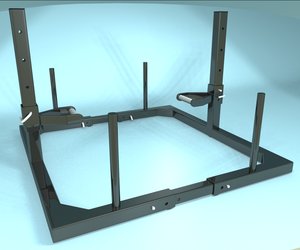Home
Arch
"There is no point in being alive if you cannot do the deadlift" - Jón Páll Sigmarsson

Preamble
There's a scene in Any Which Way You Can which shows Clint Eastwood lifting an engine block from one position to another. Later on his fight rival played by William Smith asks him about how he gets strong. "Mostly lifting 400-lb engine blocks", says Eastwood, "That should do it." says Smith... I'm paraphrasing, because I don't remember the exact words.
In short the 2 fighters recognise that 'strength' comes from picking up big weights. The Deadlift is such an exercise, it is much more practical than lifting engine blocks because you can easily adjust the weight and you won't get all greasy.
In weight training a deadlift is any lift whereby a weight is picked up using the 'posterior chain' with the arms acting in 'hook like' fashion as in the image of me above.
Quite often people can get quite dogmatic about lifting and the deadlift gets its fair share of dogmatism, with people telling others they are doing it wrong.
There are many ways and styles of lifting correctly and even more ways and styles of lifting incorrectly. However there is no 'one' way of lifting correctly...
Spine
It is sometimes said that lifting with an arched back can cause injuries, however in my nearly 4 decades of lifting I have yet to see evidence of this, at most a person might not be comfortable in an arched position so they might need to brace themselves in a slightly unarched position. In fact a big part of the McKenzie method of treatment consists of centralising back pain by doing mainly arching type exercises.
In short lifting with a round back rather than an arched back is more likely associated with back pain or injury.
Whilst it might be argued that a deadlift can be round backed or arched backed, it would be wrong in both cases to lift without generating a lot of intra-abdominal pressure (which I discuss here). If you do lift with with a round back you would most likely want to keep the rounding to a certain limit and you would most likely be lifting in such a fashion because you are maximising the amount of weight you want to lift (for example if you are a powerlifter or just want to see how much you can lift). It can also be argued that you might want to practice lifting with a round back so that if you have to lift with a round back you would be more prepared.
If you are deadlifting because you want to get strong or build muscle of get 'fit' then I would say that deadlifting in arched back style is best simply because it minimises injuries and therefore maximises the amount of time you can remain training.
So how does one perfect the deadlift with an arched back?
-
Stand up straight and arch the back strongly by sticking the bottom out like a chicken.
-
Keep the back tightly arched and bend forward at the hips. Don't round forward, hinge at the hips.
-
Let the arms hang down during the movement, you will find that you can only reach down to about the knees. If you can reach further you are rounding the back, don't do that.
-
Once you are at about knee level with the hands the only way you can go down further is to round the back or flex at the knees.
-
Don't round the back, flex the knees to get lower - keep the back tightly arched. Your back muscles should be aching from the tight isometric arch.
So the lift looks similar to a Romanian Deadlift... but isn't. Practice the lift with a light barbell. Start in a power rack with the bar a bit below the knees. Get used to holding a tight arch. Gradually increase weight and increase the range of motion, but keep the back tightly arched. Don't worry about getting injured from using weight on a tight arched back, the weight will be constantly trying to un-arch you, you will be doing everything you can just to maintain the arch.
Because the back is arched the hamstrings and glutes reach maximum stretch during the lift which means they get stronger at this point.
There is always a proviso with exercise prescription, so if a tight arched back actually makes your back ache more then don't do it... however your back will more than likely feel much better from tight arched back deadlifts.

Cycle
As a practical example. My back had been aching for some years every time I did deadlifts. It got to the point where I was taking more time to recover from the herniated, kicked in the kidneys feeling of over stressed spinal ligaments than I was actually deadlifting. Finally it culminated in me taking a day off work because my back was more painful than it had ever been in my 37 years or so of lifting. I knew that if I did bodyweight stuff and accessory lifts that my back would recover but I also wanted to do deadlifts, but I had to figure out how to deadlift without further aggravating my back. So I did arched back deadlifts.
Regular Deadlifts
I worked up to the deadlift of 143 kg × 20 reps, at the beginning of this article, by doing the following;
| Height | Weight | Reps | |
| Week 1 | 325 | 103 | 25 |
| Week 2 | 305 | 123 | 21 |
| Week 2 | 245 | 143 | 20 |
I started and finished the set in the monolift hooks. This meant i could keep the back tightly arched. At the beginning of the cycle I had the bar 80 mm above the low point, this further allowed me to keep a tight arch.
Trap Bar Style Deadlifts
After this cycle I worked up to tight arched trap bar style lifts, using my 2/4 Bar;

| Height | Weight | Reps | |
| Week 1 | 340 | 112 | 30 |
| Week 2 | 320 | 132 | 25 |
| Week 3 | 285 | 152 | 20 |
| Week 4 | 240 | 162 | 20 |
Accessories
I also accessory work over various cycles and continue to do accessory work.
26th September 2023